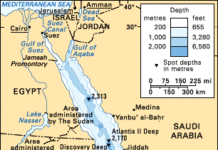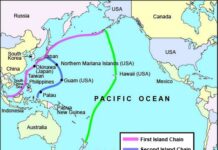
Assessment: Partners But Not Allies – New Zealand and the US Sign The Washington Declaration
Assessment/Analysis – By Dr Paul G. Buchanan.

What is different in the Washington Declaration is that the military-to-military bilateral relationship is now taking concrete shape, whereas the Wellington Declaration was a diplomatic opening rather than a definitive outlining of military areas in which joint operations and exercises will occur.
Professor Robert Ayson of Victoria University in Wellington described the relationship as a defacto alliance between the US and New Zealand. Professor Ayson used the phrase because the US and New Zealand are not entering a formal alliance agreement but a “strategic partnership.” An alliance is essentially a contract with mutual obligations; a partnership is a looser arrangement in which obligations are voluntarily assumed but not contractually defined, binding or specified. Partnerships can be reviewed and modified on a case by case or temporal basis, whereas alliances commit the parties to treaty-strength obligations that require a major diplomatic rupture for them to be abrogated. This distinction theoretically gives the US and New Zealand a greater degree of flexibility in their relations with each other on military issues. That is diplomatically advantageous for New Zealand , which seeks to preserve its image and reputation for foreign policy independence, and also avoids domestic voter backlash to the resumption of something akin to the ANZUS alliance so spectacularly undone by New Zealand’s 1985 non-nuclear announcement. The Labour, Green and Mana parties, in particular, would have been very resistant to the restoration of a formal military alliance with the US, so on political grounds the strategic partnership agreement works out very well domestically as well as bilaterally.

In practice, the strategic partnership with the US aligns New Zealand with other “first tier” US security partners in the Western Pacific Rim such as Australia, Thailand, Singapore and the Philippines. This is important for the New Zealand Defense Force (NZDF) as it seeks to integrate more closely with Australian Defense Force operational doctrine, training and equipment (as was suggested by the NZDF 2010 Defense White Paper) at a time when Australia and the US are deepening their bilateral security ties (evident in the recently announced agreement to forward base a US Marine rapid response force in Darwin). Professor Ayson is essentially right in that the NZDF will now be working side by side with the US military on a regular and continuous basis in specified areas (such as the upcoming RIMPAC naval exercises that the Royal New Zealand Navy (RNZN) has joined for the first time in two decades), although NZ will have a little more leeway in refusing US requests to join in foreign conflicts than if it had signed a formal alliance agreement that required both parties to come to their respective defense.
The resumption of near-complete bilateral military ties between New Zealand and the US is not a surprise. The 5th Labour government (1999-2008) started the rapprochement with the US post 9/11, and the National governments that followed it have openly embraced the prospect of finally overcoming the post-ANZUS freeze in security relations (with the exception of intelligence-sharing, which never suffered the curtailment of ties seen in military relations). Labour was wary of being seen as getting too close to the US, since that could jeopardize its reputation for an “independent and autonomous” foreign policy stance, particularly amongst non-aligned and small states. National prefers to embrace the US more whole-heartedly, in part because of the belief that there will eventually be economic as well as military benefits in doing so (such as via the Transpacific Partnership trade agreements currently being negotiated by the US, New Zealand and seven other Pacific Rim states). The idea behind National’s approach appears to be to use the improved military ties with the US as a hedge against the rise of the People’s Republic of China (PRC) by countering or balancing increased economic dependence on the PRC with the strengthening of economic and military ties with the US and other pro-Western nations along the Pacific periphery. National seems to believe that this balancing act (or straddling of fences), continues the tradition, or at least appearance of independence in foreign affairs.
That may be a mistake because independence in foreign affairs is most often predicated on neutrality with regards to foreign conflicts or great power rivalries. In aligning itself more closely with the US on military matters, New Zealand loses that appearance of neutrality in international security affairs. The New Zealand Foreign Affairs and Defense ministries may believe that this is the best hedge against attempts by the PRC to exploit its economic relationship with New Zealand (since the PRC is clearly the dominant partner in the bilateral Free Trade Agreement (FTA) with New Zealand and has much leverage on New Zealand when it comes to Chinese market access as well as exports and investment from the PRC to New Zealand). Balancing economic dependence on China with strengthened security ties with the US (and its allies) may appear to National to be the best way of New Zealand having its cake and eating it.

Strengthening of political ties with the US is part of National’s larger policy of reaffirming diplomatic alignment with traditional partners. The belief is that New Zealand shares more in terms of core values with these traditional partners due to the Anglo-Saxon liberal democratic traditions that bind them together, rather than the mixed Confucian-Communist-Nationalist values that underpin the core beliefs of the Chinese political elite (or the Islamic beliefs of New Zealand’s Middle Eastern trading partners). Even if the PRC was to continue growing economically at a pace similar to the last decade (which now seems improbable), it seems prudent under this logic for National to reaffirm its Western heritage, joint vision and general orientation until such a time as China and other non-Western authoritarian states begin to open up politically. Reaffirming political ties to the US and other traditional allies does not undermine New Zealand’s position with Asian democracies like India, South Korea, Taiwan or Japan, or with Southeast Asian democracies (such as they are) like Malaysia, Indonesia and the Philippines. All of these countries, as well as Southeast Asian authoritarian states such as Singapore and Viet Nam, fear the rise of China as a military power and/or economic hegemon in the Western Pacific, and therefore welcome any counter-balancing efforts on the part of the US and its strategic partners and military allies. The political alignment with the US also fits in line with the foreign policy approaches of Australia and the UK, and reasserts New Zealand’s position within that informal alliance structure (Canada is part of it as well).
There are benefits for both the US and New Zealand in this restored relationship. The benefits for New Zealand are that the NZDF will get to conduct exercises and operations with the most hardened, experienced and technologically advanced military in the world. That will expose it to the latest in US strategic doctrine and tactics. It may also result in the US providing military equipment to and training opportunities for New Zealand that it otherwise could not afford. It will reassure New Zealand of the implicit US defense guarantee in the event that New Zealand were to be threatened or attacked (to include economic coercion by the likes of the PRC). It may lead to closer economic ties, although that remains an open and much debated question (there is a large literature on security partners being preferential economic partners because of the mutual trust and dependence established between them. Most of that literature was written during the Cold War and things changed after it ended, but now with the emergence of the PRC and other powers some of those old assumptions are being resurrected and reviewed, especially in the US).
For the US the agreement is win-win. It gets an immediate benefit from securing another strong security partner in the South Pacific, one that has considerable “local knowledge” and relative influence in South Polynesia. This accords with the shift in US strategic emphasis to the Asia-Pacific, which is part of a long-term strategy of ring-fencing Chinese attempts at blue water expansion into the region. In signing New Zealand to a bilateral military partnership similar to those of other Western Pacific states, the US has moved to establish a security cordon in the region, something that also serves as a force multiplier in the measure that US strategic partners commit military assets to a common cause. New Zealand’s reputation as an honest broker in international affairs gives it diplomatic cover in this effort.
More importantly, after 25 years of estrangement and New Zealand foreign policy independence, at least with regard to international security affairs, the US has finally broken down New Zealand’s resolve and returned it to the fold. Post 1985 wooing of New Zealand began during the Clinton administration and continued with his successors. 9/11 accelerated the reconciliation (under a Labour government), and the Wellington Declaration codified it. In many respects, the US’s ability to re-gain New Zealand’s signature on a bilateral military-security agreement is a triumph of long-term great power diplomacy: after years of distance it secured junior military partnership from a small democratic state that prides itself on its modern history of foreign policy independence. To be sure, fluid global conditions since 1990 have contributed to the evolution in US-New Zealand bilateral relations, but at present it appears that the US has finally managed the contratemp of New Zealand non-nuclearism with diplomatic aplomb and to its ultimate benefit.

The negatives for New Zealand could be that the US will pressure it to increase its spending on defense, now below 1 percent of GDP, to something more in line with Australia’s two percent per annum. This would be on a par with other US strategic partners and around the NATO average, but will be politically unpalatable amongst New Zealand voters, who tend to under-appreciate defense when compared with education, health and welfare. Thus any such request will be politically thorny for a New Zealand government. However, the US can leverage the fact that the NZDF is not “pulling its weight” in the strategic partnership (the Australians already say this).
For example, although the Washington Declaration speaks about closer bilateral military cooperation in the areas of maritime patrol and anti-piracy, New Zealand has very little in the way of long-range patrol and interdiction capabilities. Specifically, New Zealand only has two blue water ANZAC-class frigates, two off-shore patrol vessels and six long-range P-3 patrol aircraft, and its multi-purpose ship, the HMNZS Canterbury, spends more time in port being repaired than at sea, As for its logistical lift capability, not only is the HMNZS Canterbury unreliable, but the RNZAF C-130 fleet, at five aircraft, is also small and already stretched in terms of its operational readiness. Thus the US and Australia can pressure New Zealand governments to increase spending on defense so as to be able to perform the responsibilities and tasks that are expected of it as a strategic partner in the areas designated as joint priority.
There is the risk of being drawn into US conflicts that have nothing to do with New Zealand or an imminent threat to it. Even if New Zealand has leeway in terms of refusing a US request to get involved in a non-immediate foreign conflict, once bilateral military ties are established and consolidated they constitute a source of leverage on the part of the US since any retaliatory cancellation or disruption of the bilateral relationship will hurt the NZDF more than it will the US military. Moreover, the bilateral diplomatic backlash from a public refusal to work with the US in a foreign conflict theater could overcome any domestic and international support for the move.
There is also the more immediate issue of diplomatic fallout over the partnership. The more that New Zealand is seen as aligning itself with the US on security matters, the more US rivals such as Russia, the PRC, and various Latin American and Middle Eastern states will see it as a tool of US foreign policy and military strategy. Even other “independent” states like Uruguay, Finland, Costa Rica, Estonia and Turkey may begin to recast their view of New Zealand as a honest broker in international affairs. That is why National’s belief that its fence-straddling or hedging strategy will continue the image of independence may not work out to be the case, which could have adverse diplomatic consequences.
- Defence.govt.nz/defence-review
- 36th-parallel.com – United States, New Zealand Sign Defense Cooperation Arrangement (official announcement)
- 36th-parallel.com – US/NZ Washington Declaration (pdf)
- 36th-parallel.com – Audio Interview – Selwyn Manning On New Zealand Signing the USA’s Washington Declaration Military Pact













